Leaving no stone unturned at Green-Wood
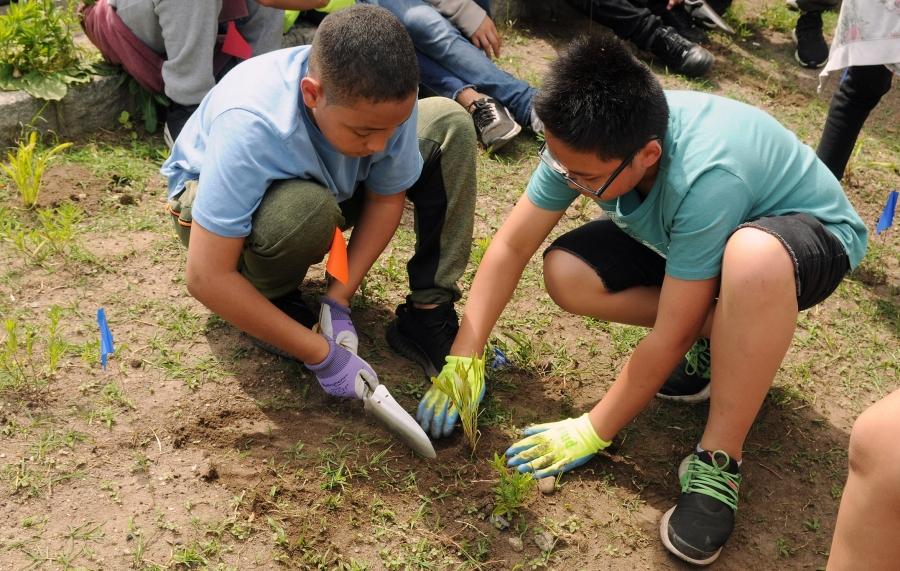
Two 6th-graders from MS 821 in the Sunset Park section of Brooklyn plant coreopsis at the Green-Wood Cemetery on June 21 as the finale to an educational tour about how pollination works.
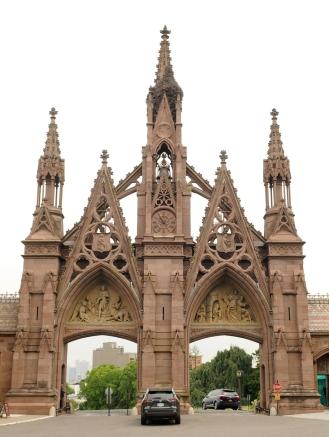
The Gothic Revival gate welcomes visitors to the main entrance of the Green-Wood Cemetery and is also home to a colony of monk parakeets.
A few dozen 6th-graders paired off at the Green-Wood Cemetery to do an exercise that contrasted two vehicles of pollination.
First, they attempted to blow pompoms made of yarn from the palms of their hands into their partners’ white paper cups. They had limited success getting the “pollen” into the “plants.”
But the opposite was true with the next activity, when students imitated insect and avian pollinators and dropped the pompoms into waiting cups.
“Wind pollination is hard to do, right? You have to depend on which way the wind blows,” said Kristi Chaudhuri, the environmental education manager at Green-Wood, a National Historic Landmark chartered in 1838 in western Brooklyn.
The backdrop to Chaudhuri’s June class-trip lesson for the students from MS 821 in the borough’s Sunset Park section included Sylvan Water pond along with an egret, an array of mausoleums and the greenery of the 478-acre cemetery and arboretum.
The pollinator tour is one of 16 tours offered at Green-Wood. Later, the students used trowels to plant perennials that attract pollinators and enrich the Green-Wood ecosystem. They dug holes for coreopsis, with daisy-like flowers; echinacea, a purple cornflower; and milkweed, all of which will grow 1-2 feet tall and greet visitors who use the Sunset Park entrance.

Rachel Walman, Green-Wood’s education director, introduces Park Slope Collegiate 7th-graders to the final resting place of Henry Chadwick, often called the father of baseball because he helped popularize the sport and create its rules.
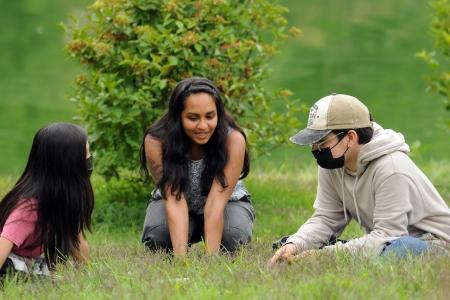
Kristi Chaudhuri, Green-Wood’s environmental education manager, chats with two 6th-graders from MS 821 at the beginning of a lesson about wind and animal pollination.
“This is a wonderful project,” MS 821 teacher Joseph Delaney said. “Anything that introduces them to this amazing environment near their homes is great.”
MS 821 math teacher Adina Benno first contacted Green-Wood in 2018 as she and her colleagues sought opportunities for children to explore their community. They took a tour to learn about the landmarks, artists and monuments so they could lead their own tours.
Green-Wood later received a grant from the Institute of Museum and Library Services to develop an environmental education curriculum, which it piloted in the 2021-22 school year. Middle school students learned about pollinators and about native and invasive species in urban grasslands in two of the tours. In a third tour titled Green-Wood: Oasis in an Urban Heat Island, they learned about the urban heat island effect, which occurs in areas where there are many buildings and roads and less greenery.
Benno said having an outdoor learning environment is a great way to have a natural “brain break” and use a community resource. Next year, the school’s program will expand to include 7th-graders.
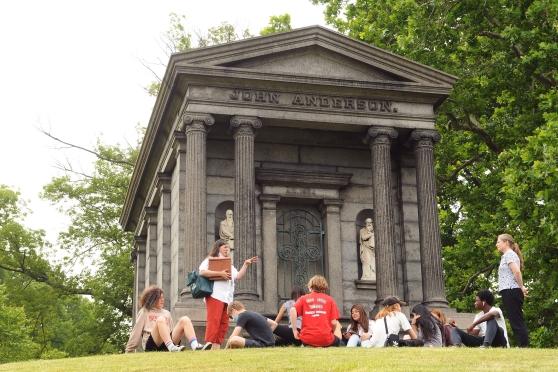
Green-Wood’s education director speaks with students and math teacher Yelena Girdo from Park Slope Collegiate MS/HS about the architectural style of wealthy tobacconist John Anderson’s mausoleum.
“It’s a really joyful natural experience that’s really good for learning and engagement,” she said.
Green-Wood provides a rich tapestry for outdoor learning for all grade levels, from history and science to art and mathematics, said Rachel Walman, the cemetery’s director of education. History tours cover the Battle of Brooklyn during the Revolutionary War; Civil War monuments; and Black, immigrant women and LGBTQ+ pioneers of Green-Wood, among other topics.
“It’s so rich,” Walman said. “You could teach every subject using Green-Wood and at every grade level.”
Earlier that day, Walman led a 90-minute architectural tour for a student circle of 10 Park Slope Collegiate MS/HS 7th-graders and teacher Yelena Girdo. Circles at Park Slope focus on social-emotional learning and building community.
As they trekked through the hilly Green-Wood terrain where more than 575,000 people are buried, Walman explained that visitors can pick up details about people’s lives from their gravesites. Albert Ross Parsons, a pianist and Egyptologist, and his wife, Alice Schuyler Van Ness, for example, are entombed in a pyramid mausoleum adorned with a combination of Christian and Egyptian symbols.
“People want to tell you something about themselves, about their loved ones in the way that they’re buried,” she said.
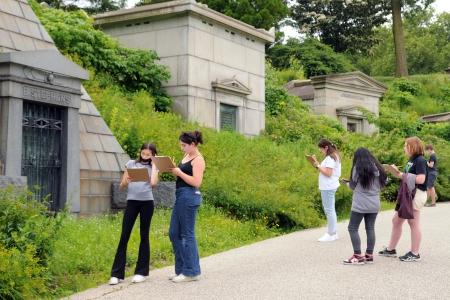
Park Slope Collegiate students end the tour by sketching a mausoleum and telling Wal-man what kind of architectural style it represents.
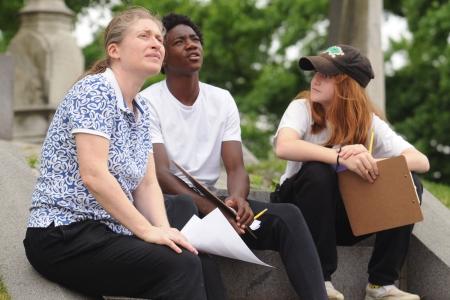
Girdo and two of her Park Slope Collegiate students survey the Green-Wood Cemetery during their architectural tour.
Walman wants students to learn how to recognize the major styles of architecture at Green-Wood and elsewhere. Many structures at Green-Wood are revivals of old architectural styles, and she provided examples, such as the Green-Wood mausoleum where wealthy tobacconist John Anderson is buried. Its Roman columns are an example of classical revival architecture, Walman said, explaining that buildings and structures in the United States that evoke ancient Greece or Rome are a way to convey power, wealth, democracy and independence.
Walman and Girdo, a math teacher at Park Slope Collegiate, discussed how the architecture tour could be connected to math through proportions and measurements, and Walman asked students to sketch one of the mausoleums carved into a hillside and describe its style.
As they drew, Girdo said the students were “reflecting on what they just learned about architectural styles. It connects to my methodologies, like wondering and noticing things, and how you can use what you already know in new concepts.”
One student said the visit changed her perspective on Green-Wood. “Now I see the different tombs as more than just stone,” she said.
The Green-Wood Cemetery, whose main entrance is at Fifth Ave. and 25th St. in Brooklyn, is open from dawn to dusk daily. Self-guided admission is free. School groups can take guided tours in 16 areas of history, architecture and environmental science. Most tours have flexible start and end points at any of the four entrance gates. For more information, visit www.Green-Wood.com or email education [at] greenwood [dot] com (education[at]greenwood[dot]com).